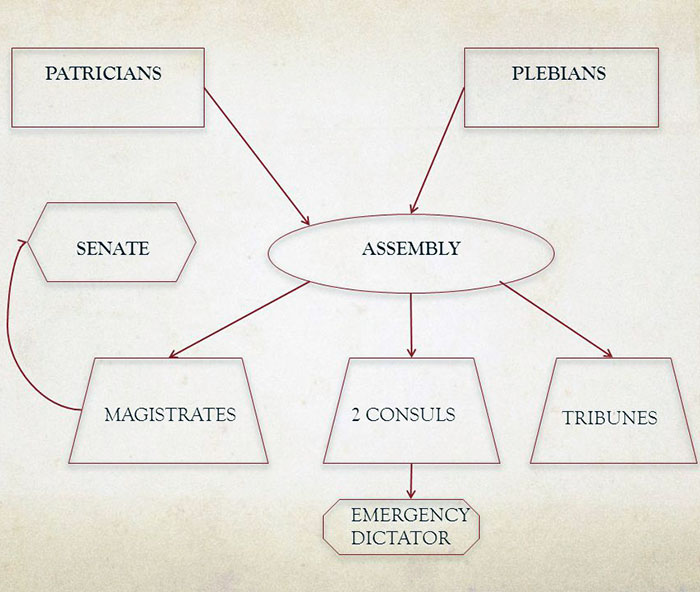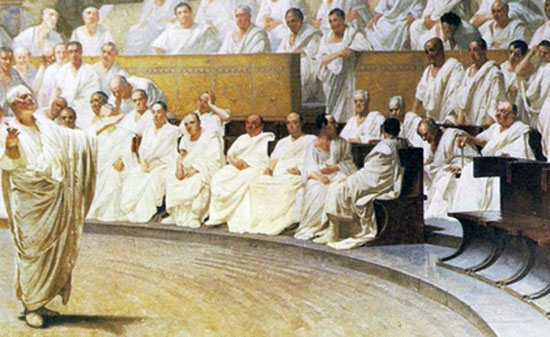The end of the struggle between the patricians and plebeians
The foreign policy of the V and III century was the first struggle for hegemony in Latin League, then conquest of Lazio and at the end, the struggle for political power on the Apennine Peninsula. At the same time, it was a struggle to expand ager publicus of Roman citizens. Shortly after the destruction of Veii, at that same place, have been made four rural tribes. Colonies were established in areas that do not touch directly with the Roman possessions and finally the portion of land that had remained undivided, Roman citizens occupied that land as well. After 445 BC, aristocracy strengthened partly at the expense of the old Latin and Campanian tribal genus. In 439 BC, Spurius Maelius was killed because he was accused that he tends to go in to tyranny because in times of famine he shared to the poor the grain. The importance of the plebeians as the main part of the army grew during the continuous wars between 70s and 60s of the IV century BC.
In 367 BC, people accepted Laws of Gaius Licinius Stolo and Lucius Sextius and according to the Licinius a power of the Consul was established again which up until then for a long time military tribunes have replaced. One Consul had to be plebeians, according to second Consul, every citizen should be allowed to have maximum of 500 iugerum of the land, while third Consul was in the interest of the debtor: residual part of the debt could be paid within three years. Sextius was the first Consul-plebeian.
Censor from the year 312 BC – Appius Claudius – built the first road to Capua (via Appia, which was of great importance in the fight with the Samnites), and he built first water supply as well.
Presumably, he was protecting the interests of trade and money circles, and in the Senate, he introduced people whose parents were freedmen. In addition, he allowed poor citizens to enrol not only in urban but also in rural tribes. Since they did not own the land, in this way they were given the opportunity to influence the decisions of the assembly. Money census was based on that fact is equated with the land census. It is possible that at this time, has fallen also Servius constitution. This great man has attributed a number of other measures: he perfected the Latin alphabet, the cult of Hercules turned from the private into public Roman cult.
State order of Roman Republic at the beginning of III century BC
Despite the success of the plebeians in the fight for their rights, the order was still aristocratic.
Comitia (Assembly)
Three types of assembly:
1. Comitia curiata (lost its importance at the beginning of the Republic). Formal authorities: ceremony of becoming a son of an emperor, writing of testaments, a ceremony of electing imperium to the magistrates
2. Comitia Centuriata: it included all highest magistrates, which were gathered in Centuriates as it was established through reform of Servius Tullius. In an earlier era, military organization coincided with the political organization. Comitia Centuriata was gathered outside the walls at the Mars Field, at dawn, and citizens were armed. Each Centuriata had one vote. According to Servius constitution, crucial importance carried citizens with high property censors.
3. Comitia Tributa – assemblies according to tribe, which were very important in the first half of the V century BC. At first, only plebeians participated in Comitia Tributa, which were drawn from the tribe in order to elect their magistrate. Later on, besides the plebeian assembly (concilia plebis), were drawn assemblies of all citizens by tribes.



In 287 BC, after Hortensia Law (Lex Hortensia), all resolutions of plebs that were passed by tribes had the force of the Law. This meant that all resolutions were equalized with Comitia Centuriata. They met in various places: Forum, the Capitol, outside the city. Curule Magistrates (consul, dictator, Praetor, curule aedisl) had the power to gather people and to preside over the Comitia. At the time, there was Comitia Tributa which was also presided by Plebeians’ Magistrates (Tribune of the People, Plebeian Aedil) which at the time was called Concilia Plebis. People voted by the tribes and if the majority of the tribe accepted the motion then this motion would become a law. This decision was called plebiscitum, later on it was called lex plebeive scitum or simply lex. Roman citizens were in fact deprived of political initiatives, because at assemblies only those resolutions were solved which the magistrate asked. Magistrates and the Senate solved all political issues.
Magistrature
There were ordinary and extraordinary magistrature. Magister – the chief had the power over people. As long as he performed the duty, he could not be dismissed or discharged from duty. This was not service but honour – privilege, respect. All duties were freely chosen for one year (except for the censors), besides dictators all duties were collegial. The general concept of government is called – potestas. The highest military power, civil power as well as certain religious functions (auspices right) – is called imperium.
At first the two consuls (they were called praetores, iudices) were the only electoral magistrates, they had all the power. After the appearance of other elective officials, consuls remained the highest magistrates – to them belonged imperium maius, i.e. they were the highest civil authority and during wartime they commanded the troops. In 367 BC, after the Licinius Stolo and Sextius Law, one consul was elected from the ranks of the plebeians.
In 443 BC, Comitia Curiata decided to chose two censors, this was done once in five years with the authority that lasted for year and a half. They determined census and they also divided citizens into tribes and centuries. From 312 BC, censors started to make lists of Senators. Finally, they participated in the financial administration of the Republic – in the sizing of taxes, customs …Questors had lowest ranking in regular magistrature. Questors supervised the treasury and financial affairs of the Roman Republic. They also supervised armies and its officers. Aediles was regular magistrature responsible for public buildings.
The Tribune
People’ tribune elected Plebeian assemblies based on the Tribes. At first, two tribunes were elected (or according to another version four tribunes) and later on ten tribunes were elected. A personality of the tribune was considered inviolable. The main function of the tribune was to protect the interests of the plebs (ius auxilii), so that they had the right to interfere in the work of the magistrates (ius intercessionis), except in the work of the dictator and censor.
Tribunes had the power to veto on a decision of the magistrate, People’s Assembly and Senate. They even had the right to arrest the magistrate. Tribune’s home was a haven for every plebeian. However tribune’s power was only limited to the city, outside of the city tribune’s power did not existed. Originally, they were unable to speak in the Senate, but they only had the right to stand in front of the door, and to protest against the decision of the Senate. Later on, they gain the right to speak at the Senate and to convene the Senate session. In the middle of the fourth century, tribunes have already enjoyed this right; they were not magistrates in the strict sense of the word.
Together with Tribune’s it was introduced a duty of the plebeian aediles, at first they were assistants of the tribunes and guardians of the temple of the goddess Cerera. Main duties were: cura urbis – supervision over an order in the city; cura annonae – feeding of the capital city and control over the streets; cura ludorum – taking care of the organization of public games.
Dictator
Extraordinary magistrates, who are called the magistrates populi, presumably belonged to the Latin Magistrates. Formally, the consuls appointed him, but in fact, the Senate elected him. It only happened in extraordinary circumstances and his power was limited by a deadline (6 months). He had all the power – summum imperium. As a sign of his remarkable power in front of him appeared 24 Lictors with bundles in which they held axes. A dictator usually determined assistant, commander of the cavalry – magister equitum for himself. At first, dictators were elected from the line of patricians, however in 356 BC, the first plebeian – dictator was mentioned.
The Senate



In the Senate, mostly entered former magistrates, while the list (album, in which senators were introduced according to their rank, first were written former consuls (consulares), then the Pretorii, etc.) was compiled first by the consul and then this duty was passed to the censors. The Senator at the head was called Princeps Senatus. According to the place on the list, each senator would gave its opinion, and after that a process of voting and decision-making (Senatus consultum, dekretum) would start.
Formally, the Senate was an advisory institution with the magistrates, and in fact, Senate turned into the highest institution of the Roman Republic, which resolved the issues of religion and cult, government finance, internal security, and a foreign policy. The people’s Assembly only formally addressed the issues of war and peace. From the beginning of the Republic, this institution was the main support of the aristocracy.
